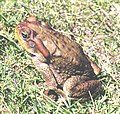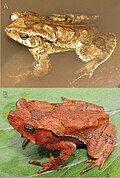| Image | Binomial name and author | Common name | Distribution |
|---|
|
 | Rhinella abei (Baldissera, Caramaschi & Haddad, 2004) | | southeastern Brazil (eastern Paraná, eastern Santa Catarina and northern Rio Grande do Sul) |
 | Rhinella achalensis (Cei, 1972) | Cordoba toad | northern Argentina (Córdoba and San Luis provinces) |
 | Rhinella achavali (Maneyro, Arrieta, & de Sá, 2004) | | Uruguay and southernmost Brazil (Rio Grande do Sul) |
| Rhinella acrolopha (Trueb, 1971) | Cerro Mali beaked toad | Serranía del Darién in eastern Panama |
| Rhinella acutirostris (Spix, 1824) | | Brazil, Colombia, Panama and Venezuela |
 | Rhinella alata (Thominot, 1884) | | Western Panama through Chocoan western Colombia to northwestern Ecuador |
| Rhinella amabilis (Pramuk and Kadivar, 2003) | | Loja Province, Ecuador |
| Rhinella angeli (Rojas, Peña, Ávila, Carvalho, Perez, Farias, Gordo & Hrbek, 2022) | | Peru |
| Rhinella amboroensis (Harvey & Smith, 1993) | Cochabamba toad | Bolivia (Cochabamba Department) |
| Rhinella arborescandens (Duellman & Schulte, 1992) | Mendoza Pass toad | Peru (Mendoza, northern Cordillera Central, in the Amazonas Region) |
 | Rhinella arenarum (Hensel, 1867) | Common toad; Argentine toad | Argentina from the Chubut Province northward, Bolivia east of the Andes |
| Rhinella arequipensis (Vellard, 1959) | Rio Chili toad | Peru |
 | Rhinella arunco (Molina, 1782) | Arunco; Concepcion toad | Chile |
| Rhinella atacamensis (Cei, 1962) | Vallenar toad; Atacama toad | Chile between Paposo (Antofagasta Region) and Las Chilcas (Valparaíso Region) |
| Rhinella azarai (Gallardo, 1965) | | Paraguay |
 | Rhinella beebei (Gallardo, 1965) | Rivero's Toad | Colombia east of the Andes and Venezuela north of the Orinoco to French Guiana; Trinidad |
| Rhinella bergi (Céspedez, 2000) | | Argentina, Brazil and Paraguay |
| Rhinella bernardoi Sanabria, Quiroga, Arias, and Cortez, 2010 | | Argentina |
| Rhinella casconi Roberto, Brito, and Thomé, 2014 | | Brazil (Ceará) |
| Rhinella castaneotica (Caldwell, 1991) | Para toad | Bolivia (Pando), Brazil (Amazonas, Pará, and Rondônia), Colombia (Amazonas, Caquetá, and Putumayo) and eastern Peru |
| Rhinella centralis Narvaes and Rodrigues, 2009 | | Panama (Chiriquí) |
| Rhinella ceratophrys (Boulenger, 1882) | Horned toad | Colombia, southern Venezuela (Cerro Neblina and Cerro Marahuaca), eastern Ecuador, northeastern Peru (Loreto), Brazil |
 | Rhinella cerradensis Maciel, Brandão, Campos, and Sebben, 2007 | | Brazil (Piauí, Bahia, Goiás, Mato Grosso and Distrito Federal), Argentina (Corrientes) |
| Rhinella chavin (Lehr, Köhler, Aguilar & Ponce, 2001) | | Peru (Huánuco) |
| Rhinella chrysophora (McCranie, Wilson & Williams, 1989) | Rio Viejo toad | Honduras |
| Rhinella chullachaki (Castillo-Urbina, Glaw, Aguilar-Puntriano, Vences, and Köhler 2021) | | Peru (Huánuco) |
| Rhinella cristinae (Vélez-Rodriguez & Ruiz-Carranza, 2002) | | Colombia(La Pedrera, Amazonas Province) |
 | Rhinella crucifer (Wied-Neuwied, 1821) | Striped toad | eastern Brazil between the states of Ceará in the north and Rio de Janeiro |
 | Rhinella dapsilis (Myers & Carvalho, 1945) | Bom Jardim toad | Brazil, Colombia, Ecuador and Peru |
 | Rhinella diptycha (Cope, 1862) | Cope's toad; cururu toad | Argentina, Paraguay, Uruguay, eastern Bolivia, and eastern and southern Brazil |
| Rhinella dorbignyi (Duméril & Bibron, 1841) | Dorbigny's toad | northeastern Argentina, Uruguay and southeastern Brazil |
| Rhinella exostosica Ferrão, Lima, Ron, dos Santos & Hanken, 2020 [7] | | Bolivia (Beni and Pando Departments), Brazil (Rondônia) and Peru (Departments of Ucayali and Madre de Dios) |
 | Rhinella fernandezae (Gallardo, 1957) | Bella Vista toad | Argentina, Brazil, Paraguay and Uruguay |
 | Rhinella festae (Peracca, 1904) | Valle Santiago beaked toad | Ecuador and Peru |
| Rhinella fissipes (Boulenger, 1903) | Carabaya toad | Bolivia and Peru |
| Rhinella gallardoi (Carrizo, 1992) | Gallardo's toad | Argentina |
| Rhinella gildae Vaz-Silva, Maciel, Bastos, and Pombal, 2015 | | Brazil |
| Rhinella gnustae (Gallardo, 1967) | Rio Grande toad | Argentina |
 | Rhinella granulosa (Spix, 1824) | Common lesser toad | Brazil |
| Rhinella henseli (Lutz, 1934) | | Brazil |
 | Rhinella hoogmoedi (Caramaschi & Pombal, 2006) | | Brazil |
 | Rhinella horribilis (Wiegmann, 1833) | Cane toad | north-western South America |
| Rhinella humboldti (Gallardo, 1965) | Rivero's toad | Colombia, Venezuela, Trinidad and the Guianas |
 | Rhinella icterica (Spix, 1824) | Yellow Cururu toad | northeastern Argentina (Misiones Province), southern Brazil and eastern Paraguay |
| Rhinella inca (Stejneger, 1913) | Inca toad | Peru |
| Rhinella inopina Vaz-Silva, Valdujo, and Pombal, 2012 | | Minas Gerais, southeastern Brazil |
| Rhinella iserni (Jiménez de la Espada, 1875) | Rio Perene toad | Peru |
 | Rhinella jimi (Stevaux, 2002) | Cururu toad | Brazil (between Bujaru in northeastern Pará and Maranhão in the north, south to Bahia and Vitória, Espírito Santo) |
| Rhinella justinianoi (Harvey & Smith, 1994) | El Chape toad | Bolivia |
| Rhinella kuka (Köhler, Vences, Padial, Plewnia & Lötters 2023) | | Bolivia |
| Rhinella leptoscelis (Boulenger, 1912) | | Peru |
 | Rhinella lescurei Fouquet, Gaucher, Blanc and Velez-Rodriguez, 2007 | | French Guiana, Suriname |
 | Rhinella lilyrodriguezae Cusi, Moravec, Lehr, and Gvoždík, 2017 | Lily Rodriguez's beaked toad | Peru |
| Rhinella limensis (Werner, 1901) | Peru Coast toad | Peru |
| Rhinella lindae (Rivero & Castaño, 1990) | Murri beaked toad | Colombia |
| † Rhinella loba Pérez-Ben, Gómez & Báez, 2019 [8] | | Argentina |
 | Rhinella macrorhina (Trueb, 1971) | Santa Rita beaked toad | Colombia |
| Rhinella magnussoni Lima, Menin, and Araújo, 2007 | | Brazil |
 | Rhinella major (Müller and Hellmich, 1936) | | Argentina, Paraguay and Bolivia and in Brazil |
 | Rhinella manu Chaparro, Pramuk, and Gluesenkamp, 2007 | | Peru |
 | Rhinella margaritifera (Laurenti, 1768) | South American common toad | Panama, Bolivia, Brazil, Colombia, Ecuador, French Guiana, Guyana, Peru, Suriname and Venezuela |
 | Rhinella marina (Linnaeus, 1758) | Cane toad | South and mainland Central America |
 | Rhinella martyi Fouquet, Gaucher, Blanc and Velez-Rodriguez, 2007 | | Suriname |
| Rhinella merianae (Gallardo, 1965) | | Venezuela (Bolívar), Suriname, Guyana, Brazil |
 | Rhinella mirandaribeiroi (Gallardo, 1965) | | Brazil(Bahia, Maranhão, Mato Grosso, Mato Grosso do Sul, Minas Gerais, Pará, and Piaui), Bolivia (Santa Cruz) |
| Rhinella multiverrucosa (Lehr, Pramuk & Lundberg, 2005) | | Peru (Pasco) |
| Rhinella nattereri (Bokermann, 1967) | | Venezuela (Bolivar), Guyana |
| Rhinella nesiotes (Duellman & Toft, 1979) | Laguna toad | Peru |
| Rhinella nicefori (Cochran & Goin, 1970) | Colombian beaked toad | Colombia (Antioquia) |
| Rhinella ocellata (Günther, 1858) | Ocellated toad | Brazil |
 | Rhinella ornata Spix, 1824 | | Brazil |
| Rhinella paraguas Grant and Bolívar-Garcías, 2014 | | Colombia (Chocó) |
| Rhinella paraguayensis Ávila, Pansonato, and Strüssmann, 2010 | | Paraguay |
| Rhinella parecis Ávila, Morais, Perez, Pansonato, Carvalho, Rojas, Gordo & Farias, 2020 | | Brazil |
| Rhinella pleuroptera Schmidt, 1857 | | Peru |
 | Rhinella poeppigii (Tschudi, 1845) | Gray toad | Ecuador, Peru and Bolivia |
 | Rhinella proboscidea (Spix, 1824) | Beaked toad | Brazil, Colombia, Ecuador and Peru |
| Rhinella pygmaea (Myers & Carvalho, 1952) | Rio Parahyba toad | Brazil |
| Rhinella quechua (Gallardo, 1961) | Incachaca toad | Bolivia |
 | Rhinella roqueana (Melin, 1941) | | northern Peru, eastern Ecuador (Pastaza), Amazonian Colombia (Amazonas and Caquetá Departments), Brazil |
| Rhinella rostrata (Noble, 1920) | Mesopotamia beaked toad | Colombia (Antioquia) |
 | Rhinella rubescens (Lutz, 1925) | | Brazil |
| Rhinella rubropunctata (Guichenot, 1848) | Rusty toad | Chile and Argentina |
| Rhinella ruizi (Grant, 2000) | | Colombia (Antioquia) |
| Rhinella rumbolli (Carrizo, 1992) | Salta toad | Bolivia |
 | Rhinella scitula (Caramaschi & de Niemeyer, 2003) | | Paraguay (Amambay and Concepción Departments), Brazil (Mato Grosso do Sul) |
| Rhinella sclerocephala (Mijares-Urrutia & Arends-R., 2001) | | Venezuela |
| Rhinella sebbeni Vaz-Silva, Maciel, Bastos, and Pombal, 2015 | | Brazil |
| Rhinella spinulosa (Wiegmann, 1834) | Warty toad; Huanuco toad | Argentina, Bolivia, Chile and Peru |
| Rhinella stanlaii (Lötters & Köhler, 2000) | | Bolivia (Cochabamba, La Paz and Santa Cruz) |
 | Rhinella sternosignata (Günther, 1858) | Falcon toad | Colombia and Venezuela |
| Rhinella tacana (Padial, Reichle, McDiarmid, & De la Riva, 2006) | | Bolivia (La Paz) |
| Rhinella tenrec (Lynch & Renjifo, 1990) | Antioquia Beaked Toad | Colombia |
| Rhinella teotoniensis (Ferrão, Souza, Colatreli, Hanken & Lima, 2022) | Teotonio Falls Leaf-litter Toad | Bolivia, Brazil |
| Rhinella truebae (Lynch & Renjifo, 1990) | Trueb's Beaked Toad | Colombia |
| Rhinella unapensis Rojas, Peña, Ávila, Carvalho, Perez, Farias, Gordo & Hrbek, 2022) | | Peru |
| Rhinella vellardi (Leviton & Duellman, 1978) | Alto Maranon toad | Peru |
| Rhinella veraguensis (Schmidt, 1857) | Veragua toad | Bolivia and southeastern Peru |
| Rhinella veredas (Brandão, Maciel, and Sebben, 2007) | | Brazil(Piauí and Bahia) |
| Rhinella yanachaga Lehr, Pramuk, Hedges, and Córdova, 2007 | | Peru (Pasco) |
 | Rhinella yunga (Mordavec, Lehr, 2014) | | Peru (Yungas) |



































